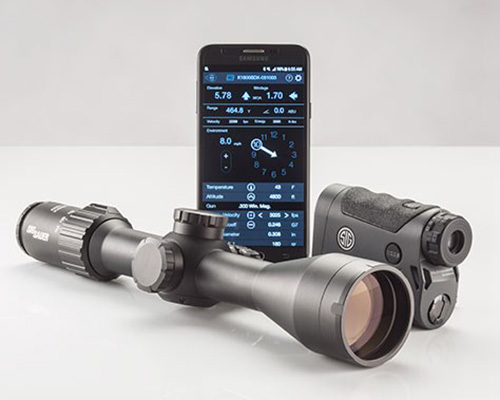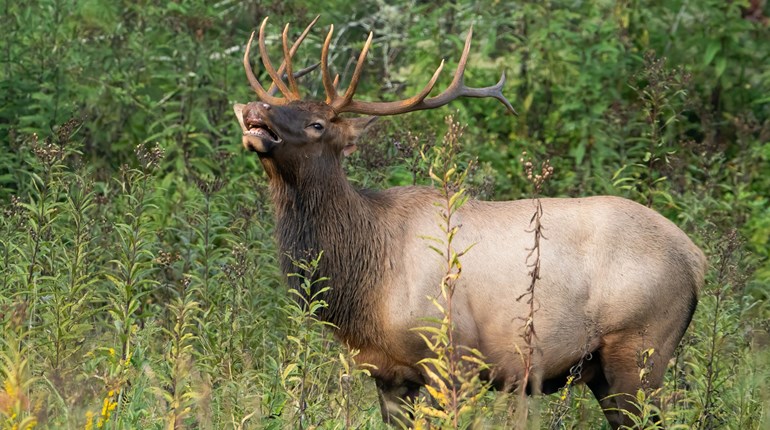
Have you ever wondered how world-class athletes stay on top for so long? Sure, they’re exceptionally talented. Yes, they maintain superior physical fitness. Absolutely they optimize elite gear. But how much does mental attitude play into their winning makeup? The same can be asked about entrepreneurs facing insurmountable odds of failure.
Public-land elk hunting may not have the same element of unsettling anxiety as golfing against Tiger Woods or competing with Jeff Bezos in the online shopping universe. Nevertheless, crushing adversities play the same mind games on you.
Statistics from Colorado Parks and Wildlife highlighting the 2018 elk season reveal the incredible odds facing you. Public-land hunting is a mainstay for elk hunters in the Centennial State, with approximately 43 percent of the state’s land mass falling into the public domain. Elk live across much of the public holdings as the state boasts the nation’s highest elk population. When you combine all Colorado elk hunters—archery, centerfire and muzzleloader—this army still only attained 19 percent success across the board. And army is an ideal description for this force that included 224,385 hunters putting in more than 1 million recreation days in the elk woods.
Could a better mental approach help you achieve a success rate higher than 19 percent? It’s very likely, but you can’t roll off the couch on Aug. 30 and walk into the forest to expect public-land elk backstraps. You do need to have a general quality of physical fitness. This means being able to repeatedly hike 2 to 3 miles into rugged country, wander for a few miles and return on the same 2-mile route. You may even be joined by 100 pounds of elk meat on the return hike.

You also need to be more than "familiar" with your hunting tool, especially a bow. That fulfills your talent needs. It's a disaster waiting to happen if your bow isn’t an extension of your arm when a bull elk passes by within spitting distance in thick timber. The same is true when a bull steps into a small opening across a canyon and you don’t instinctively know the ballistic trajectory of your rifle caliber. Budget depending, your gear should be above standard to withstand backcountry abuse.
Considering you maintain good physical fitness and understand the capabilities of your equipment, the next hurdle is the ability to force your mind into a can-do belief. I’ve never claimed to be the public-land elk guru of modern times. But I have been fortunate in my public-land elk pursuits, in my home state of Wyoming and in neighboring Montana. While analyzing my success, I’ve concluded that my physical fitness isn’t Cameron Hanes-noteworthy. My shooting abilities fall far below those of extraordinary archers like Levi Morgan. What I believe helps me overcome low odds of success is mental conviction. My mom always said I was bullheaded. I guess that attribute shines when I’m up against the best-of-the-best public-land elk during hunts with a strong chance of a belly-flop ending.
While contemplating this bullheadedness, I concluded that defining it as mental staying power had a better ring to it. Unconsciously, I was combining that mental doggedness with marketing principles I acquired in my pre-freelance career. Setting goals and end objectives was driving my above-average success on public-land elk. Maybe a mental redo combined with a marketing approach can help you on your next public-land elk hunt.
Goals
Professional business plans typically include goals and objectives. This provides staff with a layout, mental and visual, which guides them to success. For public-land elk the goal of the mission is simple: kill an elk. After you sell yourself on that straightforward ending, it’s time to put some objectives in place. Objectives establish a plan for a freezer full of elk meat.
Killing an elk can be refined further and oftentimes it depends on the area you’re hunting. Maybe you’ve invested 20 years of bonus or preference points into drawing a premier elk tag. Your goal could easily be modified from merely killing an elk to killing a trophy bull with a Boone and Crockett score of 340 points or more.
For the majority of my hunts I end up in low-success, general units where being choosy equals going hungry later. Acknowledging that, I set a mission goal to shoot any branch-antlered bull. I rarely turn away from a raghorn bull. Over the course of my hunting career, I believe that in most areas experiencing moderate to heavy hunting pressure you’ll be granted one close encounter with a bull during the course of a five-day hunt. Take it or gamble. Occasionally I lose my mission goal and gamble.
Two years ago, I drew a permit in Montana known for producing mature, high-scoring bulls. Nearly three weeks into the season I still hadn’t been within bow range of even a raghorn, but my optics were constantly fogged by my gawking breath while watching bragging bulls in the distance. Finally, one stayed in a pattern for several days. Right then and there I decided to upgrade my goals and set them on a single bull I estimated would gross in the ballpark of 390 points. It almost happened, too, but gusty, 40-mph winds forced me to let down when the bull passed by at the edge of my personal shooting limit. Eventually the bull relocated from public to private land, and while wasting time on him I passed on several satellite bulls that met my earlier goal criteria. The season ended with tag soup.
Objectives
After setting the big goal it’s time to work toward smaller objectives. These serve as boosters for a sharp, mental focus. My first objective every morning is to beat other hunters to trailheads or parking areas to launch my hunt. I enjoy sleep and believe it to be essential in maintaining an energized physical and mental approach to a draining event. Thus, I tend toward day hunts giving me nightly access to my horse trailer outfitted as a redneck camper. The hiking miles add up, but the recharge from a hot meal, bath and a bed outweighs the spent boot leather. Many of the public areas I hunt accommodate this approach.
It also allows me to launch earlier from a refreshing night. Beating other hunters to prime locations heightens my confidence, but the hike is under the cover of darkness. Hiking in predawn may sound counterproductive, but you arrive at remote basins at daybreak just as bulls fire up to nudge cows into daytime bedding cover. And along the dark trail you’ll occasionally hear bulls ring out, providing additional waypoints to investigate if needed.
Of course, several mornings of early-morning ascents that routinely cover 1,000 feet or more quickly devour mental capacity, not to mention the spiraling, physical drain. That means more objectives. Business models routinely use adjectives like “specific” and “measurable.” Waypoints provide those specific and measurable objectives. Although terrain and land managers oftentimes force you to launch from a developed trailhead, I typically leave the trail to forge a new route into rugged terrain that invites elk and discourages others who have lost their mental fortitude.

Whether using downloaded maps on a smartphone or a GPS, the waypoints glow in the dark as tiny victories. Instead of setting out for the end point of an alpine canyon 4 miles in the distance, the waypoints provide immediate triumphs every few hundred yards. The checkpoint route keeps you on the easiest path you reconnoitered, plus it’s full of short “attaboys” to advance psychological wellbeing. At shooting light you’re in a position above elk to wait for their next move.
For the next few hours of the day elk typically keep you mission-focused. Echoing bugles take you on new courses most mornings, as elk rarely follow the same route back to back. Their goal may be to reach a high ridge or mountaintop, but they tend to change up their canyon or drainage path to reach it daily.
Unless a rut explosion is occurring, by midday elk tend to calm down, leaving you with another objective to meet. Find a place to rest, one that provides the possibility for an encounter. Wallows and water sources are a main objective. It’s not uncommon for a satellite or even a herd bull to leave the vicinity of a bedded herd to beeline it to water to hydrate, or wallow. Instead of just napping under any old pine, a location with fresh elk sign gives you another bump in the confidence column.
One season I humped a treestand nearly 2,000 feet up a steep basin to place over an active wallow. Elk hit the wallow or passed within a short walk of it daily, so when bugling slowed it was routinely my next waypoint to hit. I’ve yet to arrow an elk from that stand, but two bony skeletons rest on the slopes nearby from my past success. Shady benches and trails passing through saddles offer similar, funnel situations for your midday siesta.
If the elk don’t fire up for an afternoon fiesta it pays to keep a list of afternoon locations to visit. From experience, elk generally fire back up between 3-5 p.m. If you’re not hearing bugles by then it might be time to slowly work your way back to the trailhead on a route passing by other potential party spots. Sometimes the elk don’t cooperate and you get a full night’s sleep. That’s not all bad.
Go Solo to Clear the Mind
There’s one final drain on your mental reservoir you have to consider: the impact of others joining you on the hunt. Personalities have a huge impact on how you process a situation, after all.
Don’t kid yourself: Peer pressure occurs on hunts. To maintain a level of positive energy to power through a grueling hunt, you have to surround yourself with like minds, and can-do attitudes. Hooking up with a hunting partner who has a tricked-out UTV but lacks the overall attitude to succeed in a strenuous environment sets you up for failure. His propensity to sleep in, look for easier country or even quit weighs heavily on your personal psyche.
You have two options: vet your hunts with the scrutiny of a corporate headhunter or hunt solo. Both have advantages and disadvantages. The advantage of hunting with a person matching your hunting persona gives you ample reason to assess friendships carefully. A big bonus is the calling advantage. You can separate the shooter from the caller for more advantageous ambushes. If an injury occurs there is immediate first-aid on-site. And if you find DIY public-land success, you have access to a packing partner for transporting 300 pounds of deboned elk. Obviously, there are additional advantages; you’ll know your hunting clone when you see him or her.
The solo option erases all of the above. You must execute strategies by yourself, rely on yourself for emergency rescue and pack out an elk by yourself. But there is one huge advantage: You make every decision without outside influence. Conversely, you may also compromise and share camp with a partner but hunt solo. This provides a support system but an escape from negative energy that may arise while hunting.
One of my best friends begs to join me in elk country every fall, but having shared numerous camps with him I understand his motivational pitfalls. Typically, he’s burned out by day three. However, over the past decade my average timeframe for punching a tag in general, public-land units is 10 days. In 2015 I spent more than 20 days in the woods before a dream bull lost its lucky rabbit’s foot. Many hunters don’t have the luxury of devoting that many days to a hunt, but with a psychological advantage, the days you do spend in the field could be more productive.
On my first afternoon last season I watched a dream bull through my SIG binocular. He walked out of the shadows, bugled and disappeared again. I snapped a quick picture of him as he stood in the sunlight—a reminder of the quality found in some general units. Unexpectedly, for the following seven days I played cat-and-mouse with that bull, and his harem. Goals and objectives pressed me toward daily close encounters.

By day eight I was contemplating a short break for home as I powered up the steep slope in the darkness. Clouds shrouded daybreak, but I could hear bugles echoing below, signaling the herd’s movement up the mountain. Racing back and forth across the top of the basin, I finally pinpointed their route and eased into the dark timber.
Holy cow … or bull! Right in front of me a satellite 6-point raked his antlers. He had no idea I was in his space so every time he raked, I edged closer. At 25 yards, with an arrow nocked, I was ready. But when the bull opened his squinted eyes the world exploded. I must have stood out in the young pines because he crashed off in alarm.
Knowing he hadn’t smelled me, I followed and minutes later heard antlers clashing behind a small ridge. Nocking another arrow, I started forward when nearby snapping branches prompted me to brake. A second later the monstrous head of a mature bull swayed into sight from behind the ridge. As he maneuvered his head gracefully through the maze of pines en route to me, I recognized him as the herd bull I’d been pursuing since day one. Ten yards separated us when the look in his eyes signaled I’d been discovered.
He bolted, but I mouth-mewed and he skidded to a halt broadside at 27 yards. The arrow disappeared into his side, and 10 seconds later I watched him bulldoze into the forest floor.
Public-land elk hunting definitely requires a constant pep talk to stay in the game. I was eight days into my spirit-boosting routine as I eased up to the giant animal lying before me. Every emotion you could imagine flooded through me. Surprisingly, the aches and pains had vanished.
Sir Edmund Hillary said it best: “It is not the mountain we conquer, but ourselves.” Those are words to live by while chasing public-land elk.
Western bowhunters have been embracing the single-pin bow sight for its flexibility in conquering long shots, yet its simplicity for targeting at 40 yards and less. Black Hills Archery pro shop owner Al Kraus introduced me to the system more than a decade ago. His technique is to hunt with the single pin set at 30 yards. If an elk shows up closer you aim low, and if the shot is nearer to 40 yards aim for the top of the lungs. Anything longer requires rangefinder confirmation and a quick adjustment of the pin setting. The leader in single-pin sights continues to be HHA Sports with various models to match any bank account. For more information, visit hhasports.com.

Rifle hunters also have options when it comes to technologically advanced riflescopes. SIG Sauer’s BDX system (Ballistic Data Xchange) includes trajectory data transmission between a SIG Sauer BDX rangefinder and a Sierra model-compatible riflescope. Wireless, Bluetooth technology enables data to be shared between the two units. When you range with the preset rangefinder it simultaneously sends trajectory and windage details to the riflescope. That’s when the real magic happens. The illuminated reticle automatically adjusts, making aiming at evasive elk that much faster. MSRP: $719.99-$1,679.99 (BDX combo kit); sigsauer.com.





































